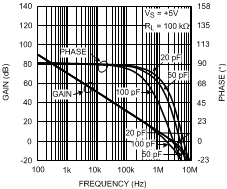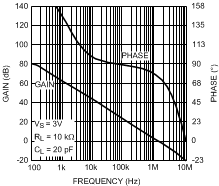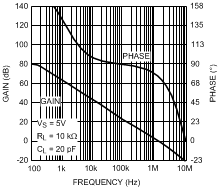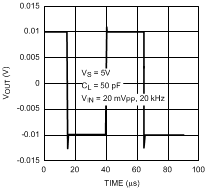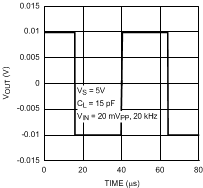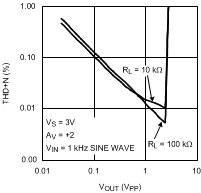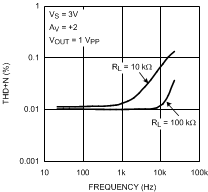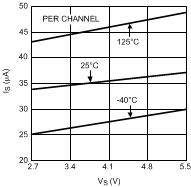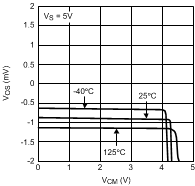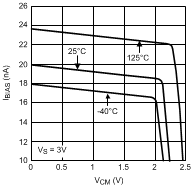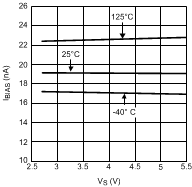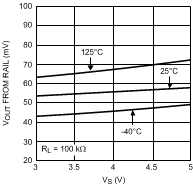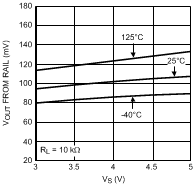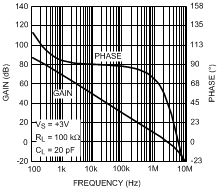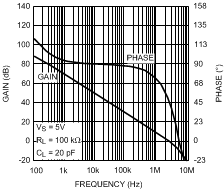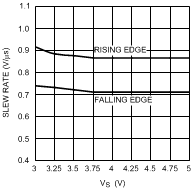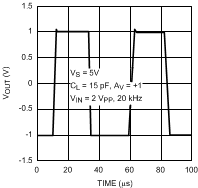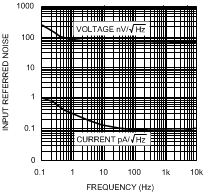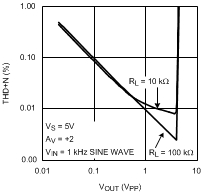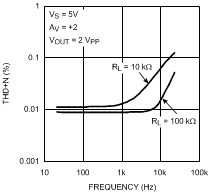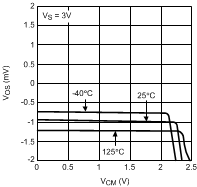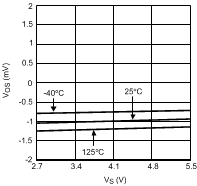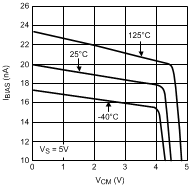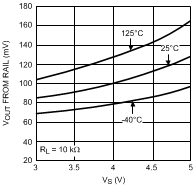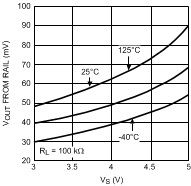SNOSAQ5H February 2007 – August 2016 LMV551 , LMV552 , LMV554
PRODUCTION DATA.
- 1 Features
- 2 Applications
- 3 Description
- 4 Revision History
- 5 Pin Configuration and Functions
- 6 Specifications
- 7 Detailed Description
- 8 Application and Implementation
- 9 Power Supply Recommendations
- 10Layout
- 11Device and Documentation Support
- 12Mechanical, Packaging, and Orderable Information
Package Options
Mechanical Data (Package|Pins)
- PW|14
Thermal pad, mechanical data (Package|Pins)
Orderable Information
6 Specifications
6.1 Absolute Maximum Ratings
Over operating free-air temperature range (unless otherwise noted)(1)(2)| MIN | MAX | UNIT | ||
|---|---|---|---|---|
| VIN Differential (at V+ = 5 V) | ±2.5 | V | ||
| Supply voltage (V+ – V−) | 6 | V | ||
| Voltage at input/output pins | V− –0.3 | V+ +0.3 | V | |
| Junction temperature, TJ (3) | 150 | °C | ||
| Storage temperature, Tstg | –65 | 150 | °C | |
(1) Stresses beyond those listed under Absolute Maximum Ratings may cause permanent damage to the device. These are stress ratings only, which do not imply functional operation of the device at these or any other conditions beyond those indicated under Recommended Operating Conditions. Exposure to absolute-maximum-rated conditions for extended periods may affect device reliability.
(2) If Military/Aerospace specified devices are required, please contact the Texas Instruments Sales Office / Distributors for availability and specifications.
(3) The maximum power dissipation is a function of TJ(MAX), θJA, The maximum allowable power dissipation at any ambient temperature is PD = (TJ(MAX) - TA)/ θJA. All numbers apply for packages soldered directly onto a PC board.
6.2 ESD Ratings
| VALUE | UNIT | ||||
|---|---|---|---|---|---|
| V(ESD) | Electrostatic discharge | Human-body model (HBM)(1) | ±2000 | V | |
| Machine model (MM)(2) | LMV551 | ±100 | |||
| LMV552 / LMV554 | ±250 | ||||
(1) Human Body Model, applicable std. MIL-STD-883, Method 3015.7.
(2) Machine Model, applicable std. JESD22-A115-A (ESD MM std. of JEDEC) Field-Induced Charge-Device Model, applicable std. JESD22-C101-C (ESD FICDM std. of JEDEC).
6.3 Recommended Operating Conditions
Over operating free-air temperature range (unless otherwise noted)| MIN | NOM | MAX | UNIT | ||
|---|---|---|---|---|---|
| Temperature (1) | –40 | 125 | °C | ||
| Supply voltage (V+ – V−) | 2.7 | 5.5 | V | ||
(1) The maximum power dissipation is a function of TJ(MAX), θJA, The maximum allowable power dissipation at any ambient temperature is PD = (TJ(MAX) - TA)/ θJA. All numbers apply for packages soldered directly onto a PC board.
6.4 Thermal Information
| THERMAL METRIC(1) | LMV551 | LMV552 | LMV554 | UNIT | ||
|---|---|---|---|---|---|---|
| DBV (SOT-23) |
DCK (SC70) |
DGK (VSSOP) |
PW (TSSOP) |
|||
| 5 PINS | 5 PINS | 8 PINS | 14 PINS | |||
| RθJA | Junction-to-ambient thermal resistance | 213.6 | 303.5 | 200.3 | 134.9 | °C/W |
| RθJC(top) | Junction-to-case (top) thermal resistance | 174.8 | 135.5 | 89.1 | 60.9 | °C/W |
| RθJB | Junction-to-board thermal resistance | 72.6 | 81.1 | 120.9 | 77.3 | °C/W |
| ψJT | Junction-to-top characterization parameter | 56.6 | 8.4 | 21.7 | 11.5 | °C/W |
| ψJB | Junction-to-board characterization parameter | 72.2 | 80.4 | 119.4 | 76.7 | °C/W |
| RθJC(bot) | Junction-to-case (bottom) thermal resistance | n/a | n/a | n/a | n/a | °C/W |
(1) For more information about traditional and new thermal metrics, see the Semiconductor and IC Package Thermal Metrics application report.
6.5 Electrical Characteristics: 3 V
Unless otherwise specified, all limits are ensured for TA = 25°C, V+ = 3 V, V− = 0 V, VCM = V+/2 = VO. (1)| PARAMETER | TEST CONDITIONS | MIN (2) |
TYP(2) | MAX(2) | UNIT | |||
|---|---|---|---|---|---|---|---|---|
| VOS | Input offset voltage | TA = 25°C | 1 | 3 | mV | |||
| TA = –40°C to 125°C | 4.5 | |||||||
| TC VOS | Input offset average drift | TA = –40°C to 125°C | 3.3 | µV/°C | ||||
| IB | Input bias current(3) | TA = 25°C | 20 | 38 | nA | |||
| IOS | Input offset current | TA = 25°C | 1 | 20 | nA | |||
| CMRR | Common mode rejection ratio | 0 V ≤ VCM 2 V | TA = 25°C | 74 | 92 | dB | ||
| TA = –40°C to +125°C | 72 | |||||||
| PSRR | Power supply rejection ratio | 3 ≤ V+ ≤ 5 V, VCM = 0.5 V |
LMV551 and LMV552 | TA = 25°C | 80 | 92 | dB | |
| TA = –40°C to +125°C | 78 | |||||||
| LMV554 | TA = 25°C | 78 | 92 | |||||
| TA = –40°C to +125°C | 76 | |||||||
| 2.7 ≤ V+ ≤ 5.5 V, VCM = 0.5 V |
LMV551 and LMV552 | TA = 25°C | 80 | 92 | ||||
| TA = –40°C to +125°C | 78 | |||||||
| LMV554 | TA = 25°C | 78 | 92 | |||||
| TA = -40°C to +125°C | 76 | |||||||
| CMVR | Input common-mode voltage | CMRR ≥ 68 dB | TA = 25°C | 0 | 2.1 | V | ||
| CMRR ≥ 60 dB | TA = -40°C to +125°C | 0 | 2.1 | |||||
| AVOL | Large signal voltage gain | 0.4 ≤ VO ≤ 2.6, RL = 100 kΩ to V+/2 |
LMV551 and LMV552 | TA = 25°C | 81 | 90 | dB | |
| TA = –40°C to +125°C | 78 | |||||||
| LMV554 | TA = 25°C | 79 | 90 | |||||
| TA = –40°C to +125°Ce | 77 | |||||||
| 0.4 ≤ VO ≤ 2.6, RL = 10 kΩ to V+/2 | TA = 25°C | 71 | 80 | |||||
| TA = -40°C to +125°C | 68 | |||||||
| VO | Output swing high | RL = 100 kΩ to V+/2 | TA = 25°C | 40 | 48 | mV from rail | ||
| TA = –40°C to +125°C | 58 | |||||||
| RL = 10 kΩ to V+/2 | TA = 25°C | 85 | 100 | |||||
| TA = –40°C to +125°C | 120 | |||||||
| Output swing low | RL = 100 kΩ to V+/2 | TA = 25°C | 50 | 65 | ||||
| TA = –40°C to +125°C | 77 | |||||||
| RL = 10 kΩ to V+/2 | TA = 25°C | 95 | 110 | |||||
| TA = –40°C to +125°C | 130 | |||||||
| ISC | Output short circuit current | Sourcing (5) | 10 | mA | ||||
| Sinking (5) | 25 | |||||||
| IS | Supply current per amplifier | TA = 25°C | 34 | 42 | µA | |||
| TA = –40°C to +125°C | 52 | |||||||
| SR | Slew rate | AV = +1, 10% to 90% (4) |
1 | V/µs | ||||
| Φm | Phase margin | RL = 10 kΩ, CL = 20 pF | 75 | ° | ||||
| GBW | Gain bandwidth product | 3 | MHz | |||||
| en | Input-referred voltage noise | f = 100 kHz | 70 | nV/√Hz | ||||
| f = 1 kHz | 70 | |||||||
| In | Input-referred current noise | f = 100 kHz | 0.1 | pA/√Hz | ||||
| f = 1 kHz | 0.15 | |||||||
| THD | Total harmonic distortion | f = 1 kHz, AV = 2, RL = 2 kΩ | 0.003% | |||||
(1) Electrical Table values apply only for factor testing conditions at the temperature indicated. Factory testing conditions result in very limited self-heating of the device such that TJ = TA. No guarantee of parametric performance is indicated in the electrical tables under conditions of internal self-heating where TJ = TA.
(2) Limits are 100% production tested at 25°C. Limits over the operating temperature range are ensured through correlations using statistical quality control (SQC) method.
(3) Positive current corresponds to current flowing into the device.
(4) Slew rate is the average of the rising and falling slew rates.
(5) The part is not short-circuit protected and is not recommended for operation with heavy resistive loads.
6.6 Electrical Characteristics: 5 V
Unless otherwise specified, all limits are ensured for TA = 25°C, V+ = 5 V, V− = 0 V, VCM = V+/2 = VO. (1)| PARAMETER | TEST CONDITIONS | MIN(2) | TYP(3) | MAX(2) | UNIT | ||
|---|---|---|---|---|---|---|---|
| VOS | Input offset voltage | TA = 25°C | 1 | 3 | mV | ||
| TA = –40°C to +125°C | 4.5 | ||||||
| TC VOS | Input offset average drift | TA = 25°C | 3.3 | µV/°C | |||
| IB | Input bias current (4) | TA = 25°C | 20 | 38 | nA | ||
| IOS | Input offset current | 1 | 20 | nA | |||
| CMRR | Common mode rejection ratio | TA = 25°C | 76 | 93 | nA | ||
| TA = –40°C to +125°C | 74 | ||||||
| PSRR | Power supply rejection ratio | 3 V ≤ V+ ≤ 5 V to VCM = 0.5 V | TA = 25°C | 78 | 90 | dB | |
| TA = –40°C to +125°C | 75 | ||||||
| 2.7 V ≤ V+ ≤ 5.5 V to VCM = 0.5 V | TA = 25°C | 78 | 90 | ||||
| TA = –40°C to +125°C | 75 | ||||||
| CMVR | Input common-mode voltage | CMRR ≥ 68 dB CMRR ≥ 60 dB |
TA = 25°C | 0 | 4.1 | V | |
| TA = –40°C to +125°C | 0 | 4.1 | |||||
| AVOL | Large signal voltage gain | 0.4 ≤ VO ≤ 4.6, RL = 100 kΩ to V+/2 | 78 | 90 | dB | ||
| 75 | |||||||
| 0.4 ≤ VO ≤ 4.6, RL = 10 kΩ to V+/2 | 75 | 80 | |||||
| 72 | |||||||
| VO | Output swing high | RL = 100 kΩ to V+/2 | TA = 25°C | 70 | 92 | mV from rail | |
| TA = –40°C to +125°C | 122 | ||||||
| RL = 10 kΩ to V+/2 | TA = 25°C | 125 | 155 | ||||
| TA = –40°C to +125°C | 210 | ||||||
| Output swing low | RL = 100 kΩ to V+/2 | TA = 25°C | 60 | 70 | |||
| TA = –40°C to +125°C | 82 | ||||||
| RL = 10 kΩ to V+/2 | TA = 25°C | 110 | 130 | ||||
| TA = –40°C to +125°C | 155 | ||||||
| ISC | Output short-circuit current | Sourcing (5) | 10 | mA | |||
| Sinking (5) | 25 | ||||||
| IS | Supply current per amplifier | TA = 25°C | 37 | 46 | µA | ||
| TA = –40°C to +125°C | 54 | ||||||
| SR | Slew rate | AV = +1, VO = 1 VPP
10% to 90% (6) |
1 | V/µs | |||
| Φm | Phase margin | RL = 10 kΩ, CL = 20 pF | 75 | ° | |||
| GBW | Gain bandwidth product | 3 | MHz | ||||
| en | Input-referred voltage noise | f = 100 kHz | 70 | nV/√Hz | |||
| f = 1 kHz | 70 | ||||||
| In | Input-referred current noise | f = 100 kHz | 0.1 | pA/√Hz | |||
| f = 1 kHz | 0.15 | ||||||
| THD | Total harmonic distortion | f = 1 kHz, AV = 2, RL = 2 kΩ | 0.003% | ||||
(1) Electrical Table values apply only for factor testing conditions at the temperature indicated. Factory testing conditions result in very limited self-heating of the device such that TJ = TA. No guarantee of parametric performance is indicated in the electrical tables under conditions of internal self-heating where TJ = TA.
(2) Limits are 100% production tested at 25°C. Limits over the operating temperature range are ensured through correlations using statistical quality control (SQC) method.
(3) Typical values represent the most likely parametric norm as determined at the time of characterization. Actual typical values may vary over time and also depend on the application and configuration. The typical values are not tested and are not ensured on shipped production material.
(4) Positive current corresponds to current flowing into the device.
(5) The part is not short-circuit protected and is not recommended for operation with heavy resistive loads.
(6) Slew rate is the average of the rising and falling slew rates.
6.7 Typical Characteristics
